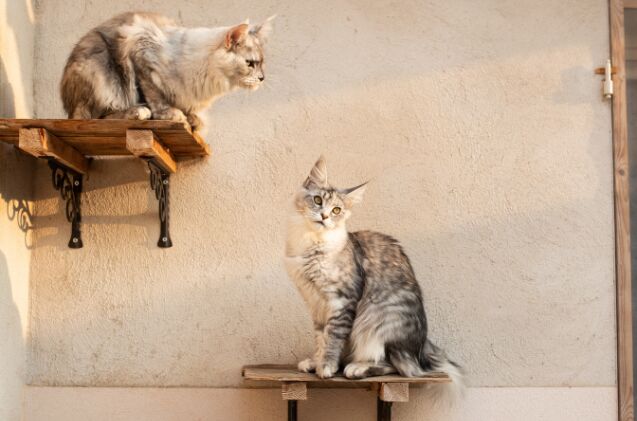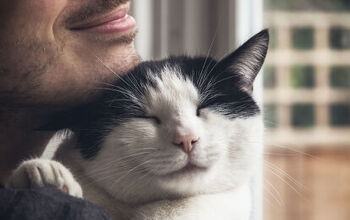How Do Cat Shelves Enhance Feline Enrichment?

Cats are natural-born climbers that love exploring their surroundings and discovering every nook and cranny. As a result, many cat lovers have seen their feline companions climbing on the fridge, bookshelves, and other furniture around the home. But what if you could offer a whole new vertical world specifically designed with them in mind?
Cat shelves are not new – many cat lovers have used them over the years. However, they have recently seen an incredible rise in popularity. The more we learn about the enrichment needs of our furry friends, the better we can adapt our home to improve their lives. These raised perches and kitty jungle gyms are a great way to do precisely that.
In this article, I will share the benefits of installing cat shelves in your home and the many types of cat shelves available. Plus, you can see how we have incorporated shelves into our new home for our two feline family members, Pippen and Jinx.
Let’s get started…
What are the Benefits of Cat Enrichment?
Cat enrichment, or feline enrichment, refers to creating an environment that allows your cat to embrace their natural behaviors. This includes jumping, climbing, hiding, pouncing, chasing, hunting, and scratching.
Many cats will tap into their instincts and natural behaviors regardless of their space – but that can create an unpleasant situation for everyone. For example, your cat starts jumping up on the furniture where you don’t necessarily want them to be or scratching your furniture. In turn, you scold your cat or try to train out these behaviors, leaving them nowhere to “be themselves.” This can lead to boredom, stress, and anxiety.
Instead, providing your cat with an enriched environment allows them to truly live their best lives. This can be as simple as incorporating a cat tree into your living room or purchasing an interactive toy for your cat to “hunt” as if they were in the wild. Or it can be as extravagant as elaborate shelving and tunnel systems around your home. The choice is yours. Regardless of which option you choose, it will provide physical and mental exercise, which is essential for a happy, healthy life.
How do you Create an Enriched Environment for a Cat?
As I already shared, there are many ways to incorporate enrichment into your home. The goal is to identify opportunities for your cat to engage in as many of their natural behaviors as possible. Some options will cater to a single behavior, while others will allow for many different behaviors to be expressed in a safe and positive way.
Here are some options to consider:
- Jumping/Climbing: An easy way to meet this need is to offer furniture your cat can climb or jump on. This could be a partially cleared bookshelf to allow for “cat space” or a designated cat tree. Cat shelves fall into this category. Many cats love to be perched high, looking down upon their surroundings.
- Hiding: Many cat parents make the mistake of thinking their cat will only need a place to hide when they are scared or anxious, but this is a natural desire that extends beyond that. Cats hide when watching their surroundings, stalking their prey (or toys), or taking a nap. Consider adding enclosed spaces like cat tents or houses that they can enjoy.
- Pouncing/Chasing/Hunting: Unlike their ancestors, your cat doesn’t have to hunt for their food, but that doesn’t mean that they don’t enjoy the process of hunting. Many different cat toys can provide them with this experience, including kick toys, cat wands, interactive toys, and puzzle toys.
- Scratching: The best known of these natural behaviors, most cat lovers understand cats love to scratch. It also plays a functional role by maintaining their nails, stretching, marking their territory with their scent, and expressing various emotions. A cat scratcher or cat tree will provide the perfect place for your cat to scratch to their heart’s content without damaging anything.
Types of Cat Shelves
As interest in cat shelves has grown, many new types, styles, and designs have emerged. Today, countless options are available to satisfy your cat’s needs while complementing any home décor. This includes industrial-style shelving, wooden perches, modern catwalks, and more. But beyond the appearance of the shelves, there are also different types of cat shelves in terms of function for you to consider. You can choose one of these options or combine several for a more elaborate layout.
Traditional Shelves
The original cat shelves, these are often wooden, metal, or plastic shelves with a carpet or cat-friendly surface attached to them. They can be short little perches that your cat can sit upon or use to jump onto another surface, or they can be extended “catwalks” that allow them to move across the room without touching the floor. Traditional shelves are the most common for those looking to stick to a budget, as you can easily take a basic bookshelf, add a strip of carpet, and you’re ready to go!
Cat Cubes
Like traditional shelves, cat cubes are a style of shelving used initially for books and knickknacks. However, holes are cut in the sides, top, or bottom to make them cat-friendly, allowing cats to move in and out of the cube space. They can be set up individually, or you can put several together to create a series of “rooms” on your wall that they can move through.
Cat Stairs
These are smaller shelves that serve as stairs to lead your cat to another elevated surface. Cat stairs can be as simple as a series of very small shelves or more elaborate, representing staircases and similar structures.
Hammocks
Cat hammocks are pieces of fabric that are extended in some way to create a “hammock” style bed. There are different styles of hammocks, and your cat’s size/weight may dictate the best option. One popular style is a wooden or metal frame with the fabric stretched across, creating the hammock in the center. This offers the most support for larger cats. A simpler style ideal for small to average-sized cats and kittens involves two posts with the fabric stretched between them like a typical human hammock.
Cat Houses/Cat Condos
Unlike cat cubes with their open front, cat houses and condos offer your cat a fully enclosed space to hide out. This meets not only their need to jump/climb getting up to the cat house, but also provides them with a safe and comfortable place to hide. We often hear snoring coming from the cat house in our living room.
Mounted Scratch Posts
Rather than placing your cat’s scratch posts on the ground, why not mount them to the wall as part of their jungle gym? Mounted scratch posts entertain cats that like to climb up them using their nails like a tree in the wild. They also provide a place for that need to scratch when the mood strikes.
Bridges
A fun style that has been seen a lot recently, cat bridges are rope bridges with planks of wood, metal, or plastic for your cat to walk across. They can be set up to offer a way to move from one perch to another, adding a new element and some variation to their environment when exploring. But be aware that not all cats are comfortable with the added movement they will experience when walking across one.
Other Cat Shelf Accessories
In addition to places to perch, sleep, and scratch, cat shelves have evolved to include many other fun elements. I have seen shelves with a built-in dish for feeding your cat on an elevated surface, shelves that incorporate different toys for an extra element of fun and play, and even shelves with small cat grass planters built into them. The options are endless.
Where is the Best Place to Put Cat Shelves?
When deciding on the best location for your cat’s shelves, you will need to consider the types of shelves and how they will use them. For example, a hammock in a very high-traffic area, like a busy hallway, may not be where they feel most comfortable relaxing. However, if you have a highly social cat, they aren’t going to want to be tucked in the corner away from the family.
Consider setting up shelves so that they can move through the more commonly used areas of your home, like your living room. Pay attention to places where they may hit and knock something over, breaking it while jumping and playing. For example, you don’t want to encourage your cat to climb on cabinets with your television or other breakable items.
Take the time to consider your cat’s route from shelf to shelf. The best shelf arrangements allow your cat to move around the room, or even multiple rooms, without needing to get down.
How Do I Get My Cat to Use Cat Shelves?
Is your cat unsure about the cat shelves you have set up? That is not uncommon! This is something new and new experiences can be intimidating. To help your cat learn to move along the shelves, consider using a positive reinforcement approach with either treats or a toy.
If your cat is food-driven, placing treats along the shelf will encourage them to step out and slowly move further and further away from their “safe space.”
On the other hand, cats that love to play can be encouraged by playing with a feather wand. Start playing on the floor or a familiar surface like the couch to get your cat excited and engaged in the game. When you see that they are actively playing with the toy, slowly move it up to the shelf, then across the shelf. Often, cats are so focused on hunting the toy that they forget to be nervous about the new surface.
Most importantly, be patient and don’t rush the process. If your cat is only comfortable taking a few steps on the first day, great! That’s a few steps more than they took in the beginning. Build on that each time you bring out the treats or toys. Before you know it, they will be flying across their new cat shelves as if they have been using them all their lives.
Our Cat Shelf Experience: TRIXIE Wall Mounted Cat Lounge Set
When we moved to our new home, one important consideration was ensuring our pets were happy. This, of course, meant providing much-needed enrichment for our two cats. We live in a cabin in the woods, with wildlife everywhere. To take advantage of that, the first cat shelf we put up was a basic long wooden shelf across a window in our living room, approximately ¼ of the way down the window. This allowed the cats to perch on the shelf while watching the birds, chipmunks, and squirrels. This shelf is also above our couch, allowing the cats to easily climb down to visit with us for attention when they desire it.
We had purchased the TRIXIE Wall Mounted Cat Lounge Set at our last house and wanted to incorporate it here, as the cats loved it. So, we used the two small steps to lead up to the window perch, and then on the other end, we placed the cat condo and the hammock.
This space has quickly become a favorite for both cats, spending most of their day sleeping in the condo or happily watching the wildlife. We have incorporated shelving into a couple of other rooms in the home, but the living room setup has been the winner!
Pros
- The cat condo provides the perfect hideaway for cats that like privacy when napping
- Each piece of the set was easy to assemble and put up
- With different colours and aesthetics, you can match the décor in most homes
Cons
- Not all cats will be comfortable using the hammock
- The plush fabric design of the set collects hair, requiring cleaning more than most cat shelves
- While a good size, the cat condo may not be big enough for larger cats
Are Cat Shelves Right for Your Home?
Deciding whether to set up cat shelves in your home will depend on your cat and their preferences. If you have a playful cat that loves climbing on your furniture, transitioning to using cat shelves should be easy. However, a skittish cat uncomfortable on unsteady or questionable surfaces may never be interested in using some types of cat shelves.
For cat lovers that live in a smaller home or apartment, this is a great way to make the most of it. By setting up shelves, you can take advantage of the vertical space. The best part is that the whole arrangement is modular, making it easy to add different elements and customize your cat’s space to suit their needs. With the many budget-friendly and even highly decorative options available, this is an excellent option for incorporating cat enrichment in most homes. I encourage every cat parent to consider them!

Britt Kascjak is a proud pet mom, sharing her heart (and her home) with her “pack” which includes her husband John, their 2 dogs – Indiana and Lucifer – and their 2 cats – Pippen and Jinx. She has been active in the animal rescue community for over 15 years, volunteering, fostering and advocating for organizations across Canada and the US. In her free time, she enjoys traveling around the country camping, hiking, and canoeing with her pets.
More by Britt

























